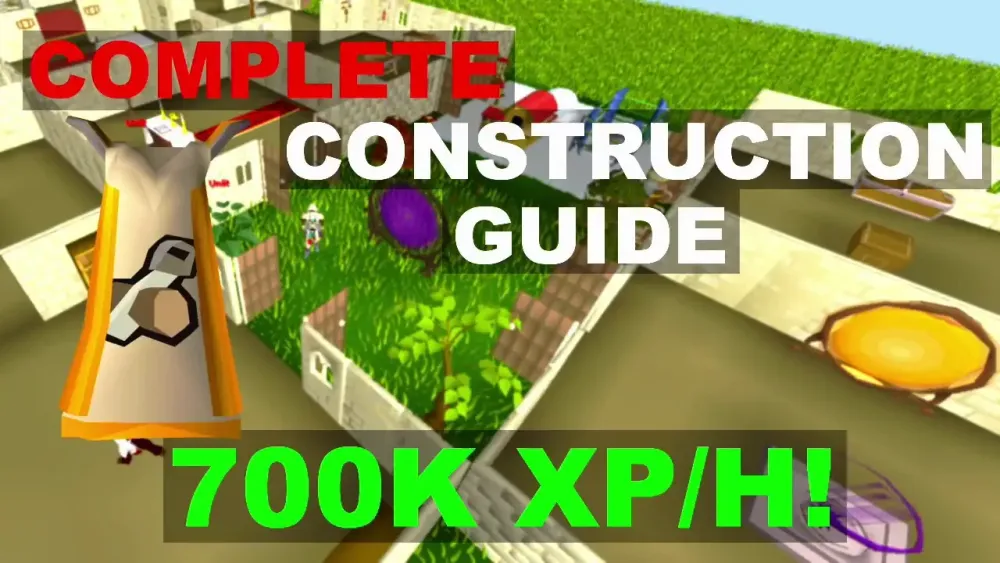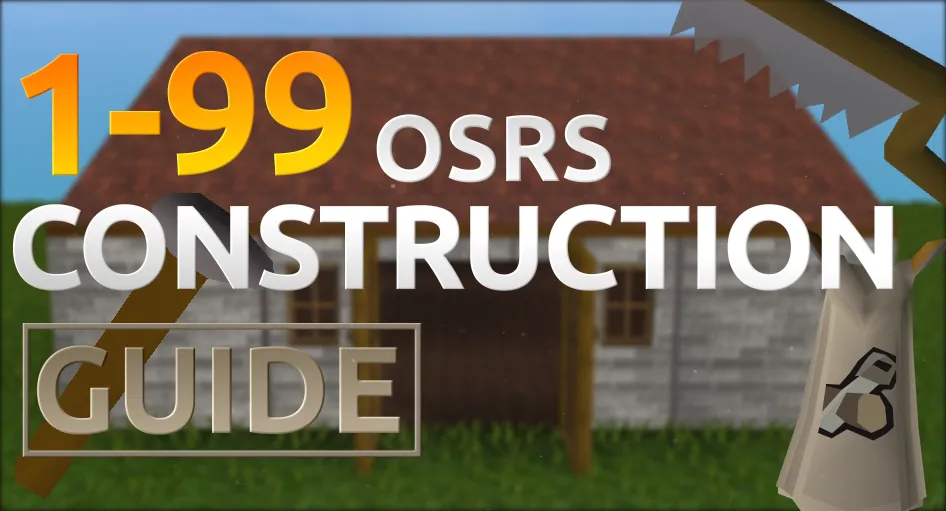Your cart is empty
Is Construction Worth It in OSRS

In Old School RuneScape (OSRS), Construction is often seen as one of the most polarizing skills. It’s expensive, time-consuming, and requires significant effort to level up. Yet, many players swear by its long-term benefits, from quality-of-life improvements to unique gameplay advantages. So, is Construction worth it in OSRS? This guide dives deep into the costs, rewards, and strategic value of training Construction to help you decide if it’s a skill worth investing in.
Construction is a members-only skill that allows players to build and customize their own Player-Owned House (POH). From functional rooms like portals to aesthetic decorations, Construction offers a mix of utility and personalization. However, it’s notorious for being one of the most expensive skills to train, often requiring millions of gold to reach high levels. So, what exactly does it offer, and why do players bother?
What Can You Build with Construction?
Your POH evolves as your Construction level increases, unlocking new rooms and items. Here’s a quick overview of what you can build:
- Portals: Teleport hubs for quick travel to key locations.
- Altars: For prayer training or bone offerings.
- Storage: Chests and wardrobes for gear and costumes.
- Utility Rooms: Kitchens, workshops, and more for practical use.
- Decorations: Aesthetic items to flex your wealth or style.
Why Construction Feels Daunting
Unlike combat or gathering skills, Construction doesn’t directly generate profit. Training it involves buying planks, nails, and other materials, which can drain your gold reserves fast. For example, reaching level 99 can cost upwards of 100 million GP, depending on your method. This high barrier to entry makes many players question its value, especially if they’re not swimming in gold.
Benefits of Training Construction

While the upfront costs are steep, Construction offers unique perks that can make it worthwhile, especially for mid-to-late-game players. Let’s break down the key advantages.
Teleportation Hub for Efficiency
One of the biggest draws of a high-level POH is the portal chamber. At level 50 Construction, you can build portals that teleport you to locations like Varrock, Camelot, or even the Wilderness. With a portal nexus (level 72), you can combine multiple teleports into one room, streamlining your travel. This saves time for PvM, skilling, or clue scrolls, making your gameplay more efficient.
Prayer and Restoration Boosts
Construction shines for players who train Prayer or engage in bossing. At level 70, you can build a gilded altar, which offers 350% experience when offering bones—ideal for fast Prayer leveling. Pair it with an occult altar (level 90) to switch between spellbooks instantly, or a rejuvenation pool (level 80+) to restore stats and hitpoints after tough fights. These features make your POH a one-stop shop for prep and recovery.
Storage and Organization
A well-built POH can act as a storage hub. From costume rooms (level 42) to store clue scroll rewards to magic wardrobes (level 80) for armor sets, Construction helps declutter your bank. This is a game-changer for hoarders or players juggling multiple activities like PvM, PvP, or skilling.
Flexing Wealth and Prestige
Let’s be honest—Construction is a status symbol. A maxed-out POH with a throne room, infernal cape rack, or a dungeon for hosting friends screams wealth and dedication. While this is more about bragging rights than practicality, it’s a motivator for some players to grind the skill.
Costs of Training Construction
Before diving into Construction, it’s crucial to understand the financial commitment. The cost varies based on your training method, level goals, and market prices for materials. Here’s a breakdown to help you plan.
Training Methods and Expenses
Construction is typically trained by building and removing furniture in your POH. The most common method involves using planks, which scale in cost by type:
- Regular Planks: ~200-300 GP each, used for early levels.
- Oak Planks: ~400-600 GP, efficient for levels 40-60.
- Teak Planks: ~800-1,000 GP, great for mid-to-high levels.
- Mahogany Planks: ~2,000-2,500 GP, fastest but priciest for 70+.
Using oak planks to level 50 might cost around 5-7 million GP, while pushing to 99 with mahogany could exceed 120 million GP. Alternative methods, like the Mythical Cape rack or servant-assisted training, can save time but still hit your wallet hard.
Cost-Saving Tips
If you’re on a budget, consider these strategies:
- Plank Make Spell: Use the Lunar spell to convert logs to planks at a lower cost.
- Sawmill Training: Process logs yourself if you have excess woodcutting materials.
- Stockpile Materials: Buy planks when prices dip on the Grand Exchange.
- Stop at Key Levels: Aim for milestones like 50 (portals) or 83 (nexus) instead of 99.
| Level | Key Unlock | Estimated Cost (Oak Planks) | Estimated Cost (Mahogany Planks) |
|---|---|---|---|
| 50 | Portal Chamber | ~5-7M GP | N/A |
| 70 | Gilded Altar | ~15-20M GP | ~25-30M GP |
| 83 | Portal Nexus | ~40-50M GP | ~60-70M GP |
| 99 | Max POH | ~80-100M GP | ~120-150M GP |
Is Construction Worth It for Your Playstyle
The value of Construction depends heavily on how you play OSRS. Let’s explore how it fits different player types to help you decide.
For PvM Enthusiasts
If you’re into bossing or slayer, Construction is a no-brainer. A POH with a gilded altar, occult altar, and rejuvenation pool saves you trips to banks or altars, letting you focus on grinding. The portal nexus also cuts travel time to bosses like Vorkath or Zulrah. For PvMers, the investment pays off in efficiency.
For Skillers
Skillers might find less immediate value unless they’re training Prayer or need storage. However, a POH with workshops (level 15+) can store tools, and teleports make skilling routes faster. If you’re a skiller with extra cash, Construction is a nice quality-of-life boost.
For Casual Players
Casual players might hesitate due to the cost. If you only play a few hours a week and don’t have millions to spare, focus on other skills first. That said, even a modest POH at level 50 can offer teleports and storage, which are handy for anyone.
For Ironmen
Ironmen benefit massively from Construction. The gilded altar and rejuvenation pool are game-changers for self-sufficient Prayer training and PvM prep. Gathering planks is tedious, but the long-term perks make it worth the grind.
Alternatives to Construction
If Construction feels too expensive or niche, there are other ways to achieve similar benefits without sinking millions into planks. Here’s how you can replicate some of its perks.
Teleportation Alternatives
Without a portal nexus, you can rely on teleport tabs, jewelry (e.g., Ring of Dueling), or spells like Home Teleport. These are cheaper but less convenient, requiring inventory space or runes.
Prayer Training Without a Gilded Altar
You can train Prayer at the Ectofuntus or Chaos Altar, both offering high XP rates. They’re slower than a gilded altar but cost nothing beyond time and effort.
Storage Solutions
Bank expansions or reorganizing your inventory can delay the need for a costume room. For Ironmen, dropping unneeded items or using mules is a workaround, though less elegant.
While these alternatives work, they lack the seamless integration of a POH. If efficiency is your goal, Construction’s benefits are hard to beat.
So, is Construction worth it in OSRS? It depends on your goals and resources. If you’re a PvMer, Ironman, or efficiency nerd with gold to burn, Construction is a fantastic investment, offering teleports, Prayer boosts, and storage that streamline your gameplay. For casual players or those strapped for cash, it’s less urgent—focus on hitting key levels like 50 or 70 for the best bang for your buck. Weigh your playstyle, budget, and long-term plans before diving in, but don’t underestimate the power of a tricked-out POH. It’s a skill that pays dividends in time saved and convenience gained.
